Nitiprakasika (Critical Analysis)
by S. Anusha | 2016 | 34,012 words
This page relates ‘Sarga V: Amuktayudha-nirupana (51 Verses)’ of the study on the Nitiprakasika by Vaisampayana which deals primarily with with Dhanurveda, i.e., the science of war, weapons and military strategies of ancient Indian society. It further contains details on Niti-shastra, i.e., the science of politics and state administration but most verses of the Nitiprakashika deal with the classification and description of different varieties of weapons, based on the four groups of Mukta, Amukta, Muktamukta and Mantramukta.
Sarga V: Amuktāyudha-nirūpaṇa (51 Verses)
This chapter elaborates on the twenty Amuktayudhās which also fall under the category of śastras. These weapons are held in hand while fighting with enemies.
Here also the physical characteristics and utility of the weapons are given in the table below:
(1) Vajra [V.2-6]
Measurements:
Pañcayojanavistaraṇa[1]
5 yojanas br. Daśayojanavistaraṇa
10 yojanas ln.
Physical Charactersistics:
Lightning coloured
Covered with 100 Knots
Periphery
Covered with Sharp Points
Broad
Strong Handle
Studded with Gems
Shines brightly like crores of Suns
Fangs extend to one yojana (10 Miles)
Tongue is horrible
Movements:
Cālana, Dhūnana, Chedana, Bhedana

(2) Īli [V.7-8]
Measurements:
Hastadvayotsedha[2]
2 cubits in.
Pañcāṅguli vistṛutā
5 fingers br.
Physical Charactersistics:
Black coloured
No handle
Front part is broad and curved
Movements:
Sampāta, Samudīta, Nigraha, Pragraha
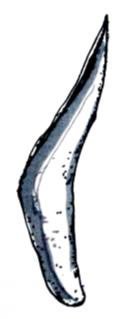
(3) Paraśu [V.9-10][3]
Measurements:
Hastadvayotsedha 31
2 cubits in.
Pañcāṅguli vistṛutā
5 fingers br.
Physical Charactersistics:
Dirty coloured
Thin stick
Broad mouth
Has head
Handle in foot end
Bent in sharp edge portion (resembles half moon)
Shining face
Movements:
Pātana, Chedana
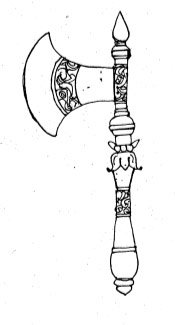
(4) Gośīrṣa [V.11-4]
Measurements:
Ṣoḍaaśaṅgulyunnatam[4]
(16 aṅgulas ln.)
Physical Charactersistics:
Dark coloured
Iron on top (triangle)
Sharp edge
Good handle
Movements:
Muṣṭigraha, Pariṣepa, Paridhi, Parikuntana

(5) Asidhenu [V.15-7]
Measurements:
Hastaunnatya pramāṇa[5]
Aṅguladvaya vistīṛṇa
(1 cubit ln. 2 thumbs/ 5 finger brd.)
Physical Charactersistics:
Dark coloured
Has handle
No hand guard
Fights people closely
Always tied to girdle
Daughter of sword
Movements:
Muṣṭiyagragraha, Pātana, Kuntana
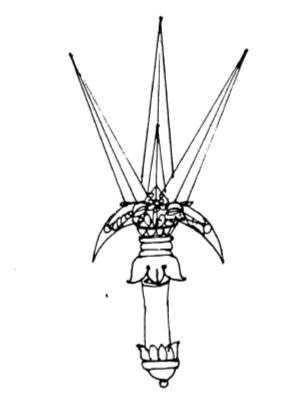
(6) Lavitra [V.18-9]
Measurements:
Sārdhahastasamunnat[6]
Pañcāṅgulivyāmam
(11/2 cubits ln. 5 aṅgulas br.)
Physical Charactersistics:
Black coloured
Broad handle
Broad at back and sharp in front
Crooked shape (curved from handle till front)
Lifted with two arms and thrown
Cuts buffaloes to pieces
Movements:
-
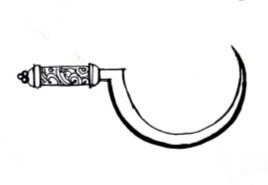
(7) Āstara [V.20-1][7]
Measurements:
-
Physical Charactersistics:
Black coloured
Knotted foot
Long head
Broad hand
Movements:
Bhrāmaṇa, Karṣaṇa, Troṭana
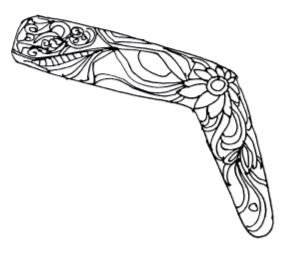
(8) Kunta [V.22-3]
Measurements:
Pañcahasta samutsedha[8]
(5 cubits ht.)
Physical Charactersistics:
Iron body
Hexagonal sharp top
Round at foot
Movements:
Uḍḍīna, Avaḍīna, Niḍīna, Bhūmilīnaka, Tiryaglīna, Nikhāta
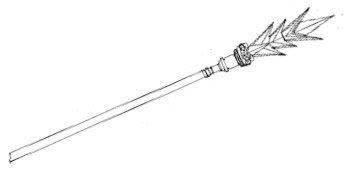
(9) Sthūna [V.24]
Measurements:
Pumpramāṇa (tnt.)[9]
tall as man Hastasthūla (com.)
I hand brd.
Physical Charactersistics:
Red coloured
Straight
Many knots close to each other
Movements:
Bhrāmaṇa, Pātana

(10) Prāśa [V.25-6]
Measurements:
Sapta hastaanumatya[10]
(7 cubits ln.)
Physical Charactersistics:
Red coloured
Made of bamboo
Metal head
Sharp at foot end
Decorated with tufts of silk at bottom part
Movements:
Ākarṣa, Vikarṣa, Dhūnana, Vedhana
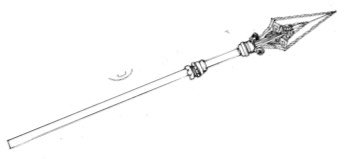
(11) Pināka [V.27-9]
Measurements:
Caturhastapramāṇa[11]
(4 cubits ln.)
Physical Charactersistics:
Three headed
Iron head
Sharp in front
Made of brass
Adorned with brass bells and hair of bear
Movements:
Dhūnana, Protana
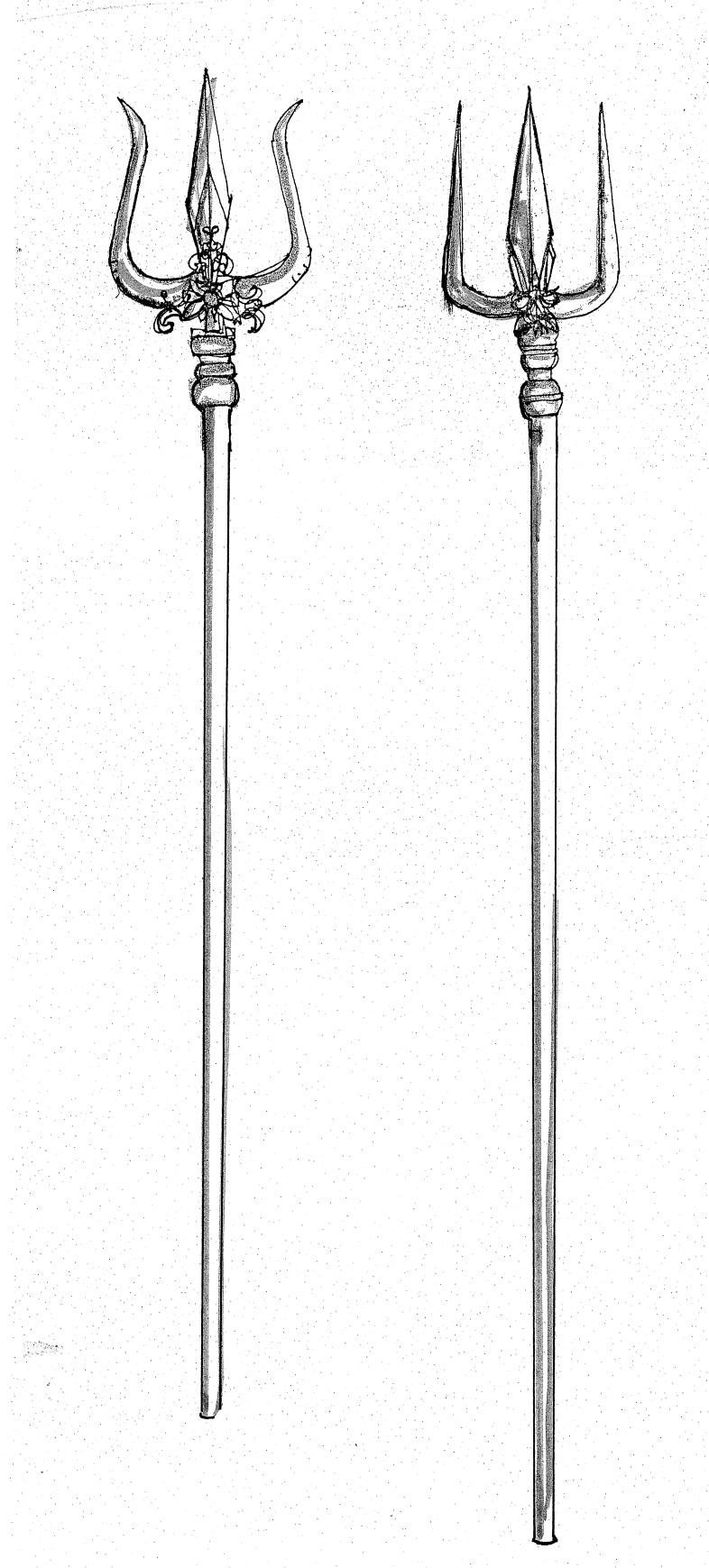
(12) Gadā [V.29-34]
Measurements:
Caturhastasamunnata[12]
(4 cubits ln.)
Physical Charactersistics:
Made of sharp iron
100 spikes on head and sides
Firm handle Frightening
Movements:
Gata, Pratyāgata, Parimorṣa, Paridhāvana, Abhidrāvaṇa, Ākṣepa, Avasthāna, Vigraha, Parivṛtta, Sannivṛtta, Avapluta, Upapluta, Dakṣiṇamaṇḍala, Savyamaṇḍala, Āviddha, Praviddha, Sphoṭana, Jvālana, Upanyasta, Apanyasta
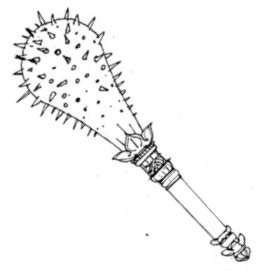
(13) Gadā [V.35-6]
Measurements:
Trihastavān[13]
(3 cubits ln.)
Physical Charactersistics:
Honey coloured
No face
Broad shoulder
Heavy (loads)
Good handle (black, round and hand in cir.)
Movements:
Bhrāmaṇa, Pātana
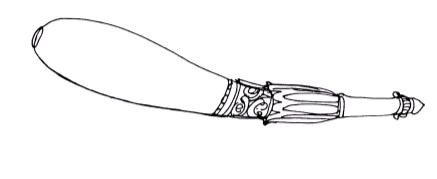
(14) Śīra [V.37]
Measurements:
Pumpramāṇa[14]
(man’s ht.)
Physical Charactersistics:
No head
Doubly curved
Iron plated front crushes objects
Movements:
-
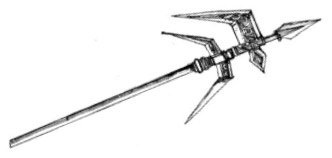
(15) Musala [V.38]
Measurements:
-
Physical Charactersistics:
No eyes/head/hand/feet
Joined together at both the ends
Crushes enemies
Movements:
Pātana, Pothana
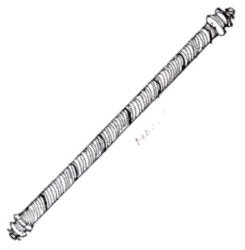
(16) Paṭṭīśa [V.39][16]
Measurements:
Pumpramāṇa
(man’s ht.)
Physical Charactersistics:
Two sharp blades and one top
Hand guard along with handle
Straight body
Movements:
-
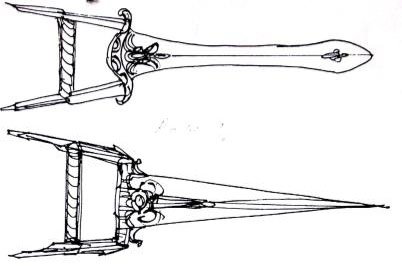
(17) Mauṣṭika [V.40-4]
Measurements:
Prādeśa unnati[17]
(span between thumb and fore finger)
Physical Charactersistics:
Dark coloured
Very good handle
High neck
Broad middle
Sharp end
Movements:
Parimokṣa, Paridhāvana, Abhidravaṇa, Āplava, Ākṣepa, Avasthāna, Vigraha, Parāvṛta, Apāvṛta, Apadruta, Avapluta, Upanyasta, Apanyasta, Ghāta, Shālana
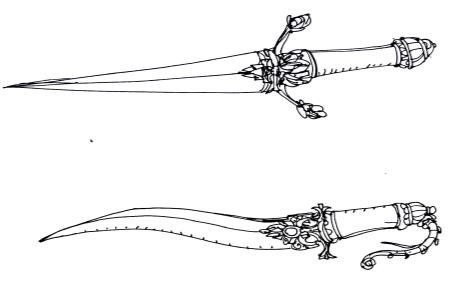
(18) Parigha [V.45]
Measurements:
Tala mātra = catur hasta (tnt)
comm. & Vaijayantī[18]
4 hands ln. {big as palmyra tree}
Physical Charactersistics:
Wooden
Round in shape
Can be wielded only by very strong men
Movements:
Pātana
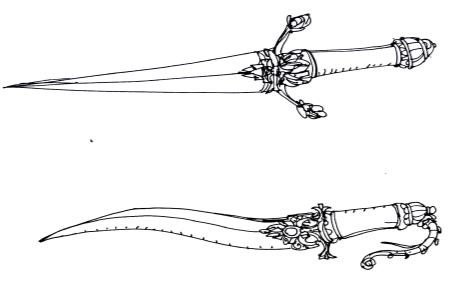
(19) Mayūkhī [V.46-7]
Measurements:
Naronnatā[19]
Physical Charactersistics:
Various colours
Staff
Has hilt
Decorated with bells
Movements:
Aghāta, Pratighāta, Vighāta, Parimocana, Abhidrāvaṇa
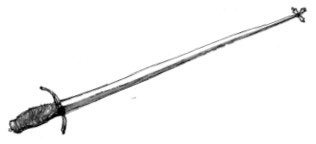
(20) Śataghnī [V.48-9]
Measurements:
Caturhasta[20]
4 cubit ln.
Physical Charactersistics:
Of black iron
Hard
Round in shape
Has horns
Has handle
Movements:
Gata, Pratyāgata, Parimorṣa, Paridhāvana, Abhidrāvaṇa, Ākṣepa, Avasthāna, Vigraha, Parivṛtta, Sannivṛtta, Avapluta, Upapluta, Dakṣiṇamaṇḍala, Savyamaṇḍala, Āviddha, Praviddha, Sphoṭana, Jvālana, Upanyasta, Apanyasta
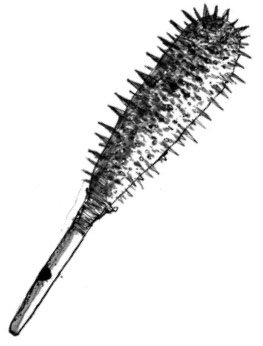
verses 50-59: Conclusion of the sarga:
The efficiency and the quality of the weapons vary and undergo changes according to the yugas and places. Much depends on the strength and ability of the wielder of the weapon. In the kali age, the text adds, machines made of metal, stone and so on and they shall be used to throw at the enemy iron balls, big rocks, smoke balls, heated oil, hot sand and so on. Such atrocities of war are ascribed to barbarous tribes who indulge in unfair battles.
This chapter comes to a close with the advice to Janamejaya to rule his subjects with a desire of doing good to them.
Tattvavivṛti on verses 59:
The various features of the twenty amuktāyudhas are presented. Of these, Pināka, Gadā and Śataghni get special attention. The different movements of all these weapons also are considered properly. The different not so dharmic weapons which shall be used in the kali age are also discussed.
Footnotes and references:
[1]:
[...]
[2]:
[...]
[3]:
[...]
[4]:
[...]
[5]:
[...]
[6]:
[...]
[7]:
[...]
[8]:
[...]
[9]:
[...]
[10]:
[...]
[11]:
[...]
[12]:
[...]
[13]:
[...]
[14]:
[...]
[15]:
[...]
[16]:
[...]
[17]:
[...]
[18]:
[...]
[19]:
[...]
[20]:
[...]
